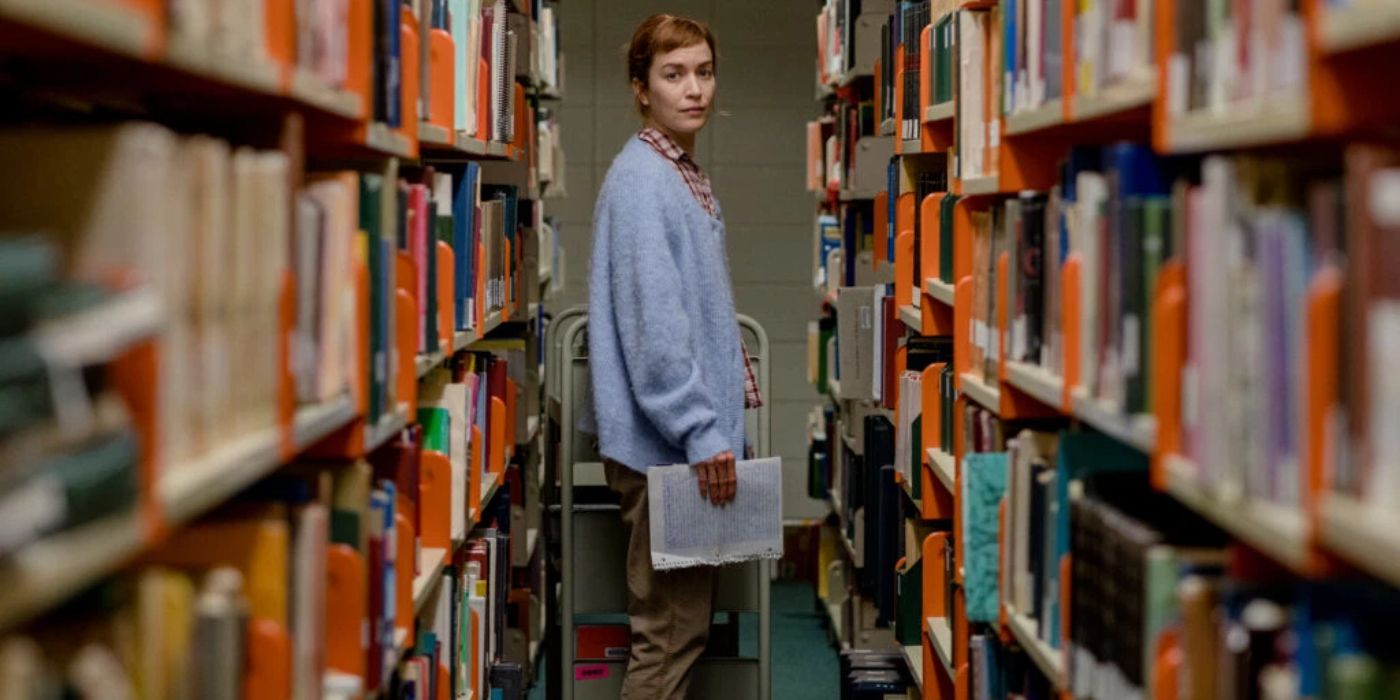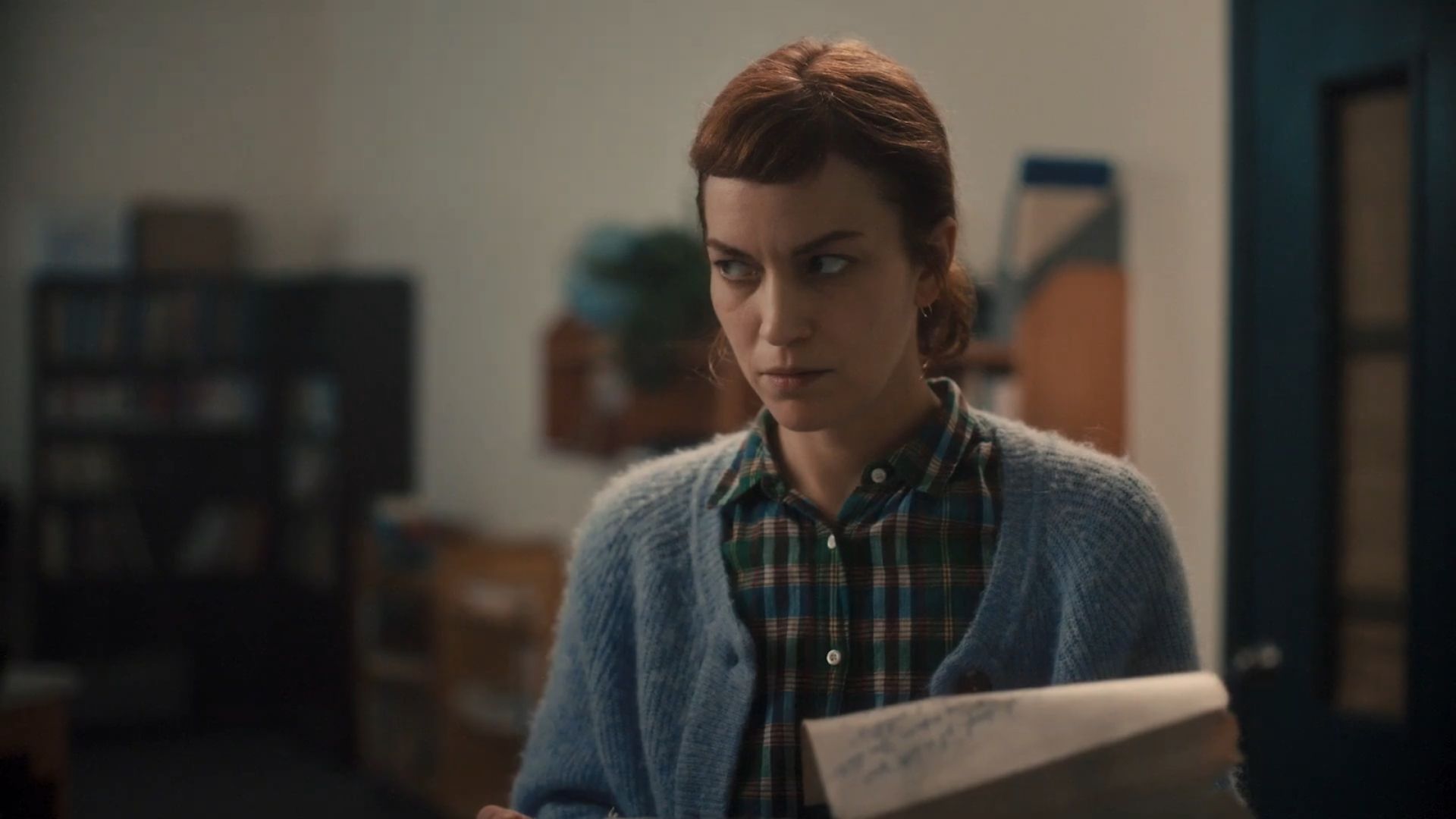
Miriam peers out on life through a windowpane, taking in the ordinary and witnessing the constant flow of people who are unaware of her presence. Yet, she too participates – pedaling gently on her bicycle with a secure helmet, arranging books at her workplace, and extending silent gestures of compassion such as preparing lunch for a fellow library-user in need. She moves stealthily, maintains her calm, and seems to be fading away from view.
In the recently premiered movie titled “Darkest Miriam“, Britt Lower delivers a captivating portrayal of a woman clinging to her existence with the finest strand of routine. This thought-provoking film, directed by Naomi Jaye, serves as an exploration on themes such as loneliness, estrangement, and the impact of work, duty, and unresolved sorrow on shaping and sometimes dismantling one’s identity. Known for his focus on memory and selfhood in his films, Charlie Kaufman lends his expertise as an executive producer, leaving traces of his unique style in the film’s puzzling handling of time, perspective, and introspection.
Debuting at Tribeca 2024 and receiving the Best Director award at the 2024 Fantasia International Film Festival, “Darkest Miriam” is a stunningly peculiar masterpiece, hinting at a mental collapse but maintaining a controlled disintegration for most of its duration. This film delves into the myriad ways an individual can vanish unnoticed. Based on Martha Baillie’s novel “The Incident Report“, “Darkest Miriam” delves deeper into these incident reports and beyond. Watching “Darkest Miriam” was akin to observing the precursor to Joyce Carol Vincent’s fate in “Dreams of a Life” (2011) – a woman gradually fading from society, her isolation so subtle and insidious that by the time she disappears, the world has already stopped seeking her.
A Portrait of a Woman on the Brink
The narrative in Darkest Miriam doesn’t explicitly state its main idea; rather, it builds its meaning subtly through scenes and insights, mirroring Miriam’s own library incident reports – a series of seemingly small disturbances that gradually unveil a woman whose life is progressively unraveling as she struggles against the very system intended to support her.
In this depiction, the library, often seen as a haven of organization and shared wisdom, takes on a more disordered aspect. The sound design, characterized by a puzzling ambiguity about whether the background piano is part of the scene or not, underscores the library as a refuge yet also a site of unwelcome intrusion. Miriam records the various individuals who cross its threshold: an elderly man with dementia, homeless patrons seeking warmth, and a stalker leaving cryptic messages. However, when observing becomes indistinguishable from being haunted, what transpires?
The movie seamlessly follows Miriam’s life with an observant touch: from her intrusive medical visit, the gradually intensifying feeling of being under surveillance, and how other people’s remarks and encounters draw her deeper into her own thoughts. However, despite focusing on isolation in Darkest Miriam, it also emphasizes the yearning for recognition.
The Love Story as a Momentary Escape



Introducing Janko, portrayed by Tom Mercier, who works as a taxi driver while nurturing his enigmatic, introspective art. He stands apart from society yet clings fiercely to an unyielding passion – a beacon that provides him solace. Miriam finds in him a link to the hope of human connection, given her past experiences. Tom Mercier delivers an electrifying performance, imbuing his character with a raw, instinctive allure that feels both poetically spontaneous and strikingly human. His on-screen chemistry with Britt Lower is tender yet charged, exuding a quiet intensity that is both organic and captivating. This connection becomes one of the film’s most powerful emotional themes.
In a break from the monotonous tranquility of her inner world, their relationship serves as a respite. However, it’s unlike traditional love stories. Miriam, often described as having an “anxious attachment,” exhibits this when she reluctantly agrees to Janko preparing tea at his place, then unexpectedly starts an intimate encounter without words – a moment filled not with passion, but with a longing for connection that he picks up on. This portrayal of intimacy is strikingly authentic, capturing the awkwardness and uncertainty of two individuals seeking companionship after extended solitude. Lower’s acting prowess is evident in her ability to convey an outwardly composed, competent woman whose actions reveal her profound vulnerability.
In the end, their short-lived romance cracks due to a revelation by Miriam that she doesn’t foresee Janko having kids. This moment is heartbreaking not for the words spoken, but for what it discloses: the stark contrast in their visions of the future. While Janko continues to picture his life moving forward, Miriam struggles to imagine anything beyond the current moment.
The Unraveling: Work, Memory, and Madness
As the movie unfolds, Miriam grows increasingly detached, not via spectacular collapses, but rather through subtle cracks in her grasp of reality. Instead of documenting library disturbances, she pens poetic accounts about her father. She resigns from her position, not due to choice, but driven by the terror of future remorse. Her frequent visits to a hole in the ground suggest a longing to retrace her steps through her trauma in search of understanding.
In a chilling scene, the movie seems to confuse past and present as the man she frequently encounters might be her father or simply a manifestation of her memories. The film implies that trauma doesn’t follow a straight path; instead, it repeats, interrupts, and redefines itself in the subtle, peaceful moments of everyday life.
The Visual Language of Isolation
In a striking manner, the film Darkest Miriam visually embodies its themes. Director Jaye and cinematographer Michael LeBlanc skillfully use changing lighting to portray Miriam’s growing detachment. Initially open spaces such as her apartment, library, or park subtly transform into oppressive environments, even when bustling with people. Throughout the film, Miriam remains a watchful observer, always looking in from the outside.
As a book-surrounded movie critic, I found myself struck by a profound sense of disillusionment when Part II began with the “I’m overwhelmed by all these books.” The question that echoed in my mind was: What does it mean to be immersed in knowledge, buried under documentation, and yet remain lost amidst endless words?
The Limits of Plot. The Power of Emotion


Despite its many merits, the movie titled “Darkest Miriam” is not perfect. Its narrative can be disjointed, occasionally wandering off course and taking an excessive amount of time before reaching its crucial starting point. The division into chapters feels redundant, serving as a framework that disrupts rather than enriches the flow. Certain scenes seem ill-conceived, most notably a full-frontal nudity scene that fails to contribute to the plot. Additionally, the film incorporates a subplot about a library stalker, which, while fitting thematically, lacks the emotional impact required to warrant its inclusion.
However, Lower’s captivating portrayal and Jaye’s intricate examination of solitude help sustain the film during its less compelling parts. It’s not often that films convey such a rich tapestry of emotions – ones grappling with sorrow, yearning, self-destruction, and subtle despair – with such subtlety. It’s uncommon to find a character as emotionally nuanced in movies, one who isn’t always predictable, doesn’t always act logically, but rather, is a deeply flawed, intensely human figure.
A Film That Lingers
Essentially, “Darkest Miriam” delves into the essence of being confined within one’s own thoughts. It explores the sanctuaries we construct for safety and the ones we relinquish to endure. In the climax of the movie, the scene of Miriam revisiting the pit she had fallen into before, gazing up at the stars above, symbolizes the film’s chilling uncertainty perfectly. Throughout the story, she has been inside, peering out. Now, she is outside, gazing upward. Has she discovered a path ahead? Or is she still seeking?
The film titled “Darkest Miriam,” produced by Younger Daughter Films, Low End, and Through the Lens Entertainment, is now playing in cinemas courtesy of Game Theory Films. You can find screening locations and times here. As for an answer, “Darkest Miriam” does not provide one. Instead, it invites us to embrace ambiguity and acknowledge that at times, all we can do is sit with the uncertainty. On April 15th, this thought-provoking film will be accessible on digital platforms and VOD.
Read More
- Silver Rate Forecast
- Black Myth: Wukong minimum & recommended system requirements for PC
- Gold Rate Forecast
- USD CNY PREDICTION
- Former SNL Star Reveals Surprising Comeback After 24 Years
- Grimguard Tactics tier list – Ranking the main classes
- Arknights celebrates fifth anniversary in style with new limited-time event
- Gods & Demons codes (January 2025)
- Maiden Academy tier list
- PUBG Mobile heads back to Riyadh for EWC 2025
2025-04-06 15:32